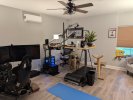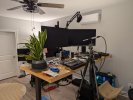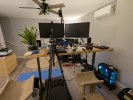I've just started to play around with REW and Equalizer APO, and I am getting results that sound "opposite" to what my ears expect. I've attached a measurement file for all speakers. This is a 2.1 setup with either a UAD Volt 1 audio interface or a PC soundcard going into a Yamaha RX-375 amplifier, which is plumbed into two Definitive Technology Promonitor 800 and a Definitive Technology subwoofer. A Dayton EMM6 was used for all measurements. I use a standing desk and the subwoofer is under the desk while the monitor speakers are on the desk. I don't have a great listening position as I'm facing into the room with the wall behind me. It's about 7.5ft from the desktop speakers to the wall. The room has no treatment and generally is pretty boomy to start with.
I struggled a fair bit to get measurements that weren't too noisy. I might need to take some measurements at an even louder SPL/sweep so that I can use less gain on the microphone input to reduce some input noise on the EMM6 noise - you tell me. I used the calibration file supplied by Dayton for the EMM6, and I did a soundcard calibration with a TRS-XLR cable going from the headphone output of the Volt to the input. The mic cal file and Volt cal file are also attached. This sweep was done with all speakers active. I tried testing each speaker individually as well but got more or less the same results.
When I try to create filters using this measurement file for Equalizer APO, I get something that ends up filtering out a lot of the highs. I had to attach measurements as text because this forum doesn't allow attaching the mdat file directly, and I don't have permission to post links (to Google Drive). I am targeting a full-range speaker and an SPL of 80 to generate the filter settings using the EQ function of REQ. Here are the filter generation settings I am using:
* Range 20-20k
* Indiv max boost 15
* Overall max 0
* Flatness 3
* Allow both shelves, -6/6
* Allow narrow filters below 200
When matching the response to the target, I get the following filters:
Filter 1: ON PK Fc 270.0 Hz Gain -5.20 dB Q 1.564
Filter 2: ON LS Fc 344.0 Hz Gain 5.90 dB
Filter 3: ON PK Fc 491.0 Hz Gain -4.60 dB Q 3.798
Filter 4: ON PK Fc 620.0 Hz Gain -6.20 dB Q 3.926
Filter 5: ON HS Fc 779.0 Hz Gain -6.00 dB
Filter 6: ON PK Fc 5278 Hz Gain -8.50 dB Q 1.443
Filter 7: ON PK Fc 9164 Hz Gain -4.10 dB Q 1.010
Filter 8: ON PK Fc 13900 Hz Gain -7.30 dB Q 1.745
Filter 9: ON PK Fc 16468 Hz Gain -5.40 dB Q 2.540
As you can see, this shelf boosts everything below 350Hz by nearly 6dB and cuts everything above that. I've attached a screenshot of what Equalizer APO looks like with the filter turned on.
These speakers are normally pretty bright, and this EQ curve does cut down on some of that brightness/harshness, but it's cutting too much, and it gets that muffled/listening through a wet blanket/through a wall tone to it. This suggests to me some kind of user error in my measurements, or that I'm doing something else completely wrong.
Thanks in advance.
I struggled a fair bit to get measurements that weren't too noisy. I might need to take some measurements at an even louder SPL/sweep so that I can use less gain on the microphone input to reduce some input noise on the EMM6 noise - you tell me. I used the calibration file supplied by Dayton for the EMM6, and I did a soundcard calibration with a TRS-XLR cable going from the headphone output of the Volt to the input. The mic cal file and Volt cal file are also attached. This sweep was done with all speakers active. I tried testing each speaker individually as well but got more or less the same results.
When I try to create filters using this measurement file for Equalizer APO, I get something that ends up filtering out a lot of the highs. I had to attach measurements as text because this forum doesn't allow attaching the mdat file directly, and I don't have permission to post links (to Google Drive). I am targeting a full-range speaker and an SPL of 80 to generate the filter settings using the EQ function of REQ. Here are the filter generation settings I am using:
* Range 20-20k
* Indiv max boost 15
* Overall max 0
* Flatness 3
* Allow both shelves, -6/6
* Allow narrow filters below 200
When matching the response to the target, I get the following filters:
Filter 1: ON PK Fc 270.0 Hz Gain -5.20 dB Q 1.564
Filter 2: ON LS Fc 344.0 Hz Gain 5.90 dB
Filter 3: ON PK Fc 491.0 Hz Gain -4.60 dB Q 3.798
Filter 4: ON PK Fc 620.0 Hz Gain -6.20 dB Q 3.926
Filter 5: ON HS Fc 779.0 Hz Gain -6.00 dB
Filter 6: ON PK Fc 5278 Hz Gain -8.50 dB Q 1.443
Filter 7: ON PK Fc 9164 Hz Gain -4.10 dB Q 1.010
Filter 8: ON PK Fc 13900 Hz Gain -7.30 dB Q 1.745
Filter 9: ON PK Fc 16468 Hz Gain -5.40 dB Q 2.540
As you can see, this shelf boosts everything below 350Hz by nearly 6dB and cuts everything above that. I've attached a screenshot of what Equalizer APO looks like with the filter turned on.
These speakers are normally pretty bright, and this EQ curve does cut down on some of that brightness/harshness, but it's cutting too much, and it gets that muffled/listening through a wet blanket/through a wall tone to it. This suggests to me some kind of user error in my measurements, or that I'm doing something else completely wrong.
Thanks in advance.




